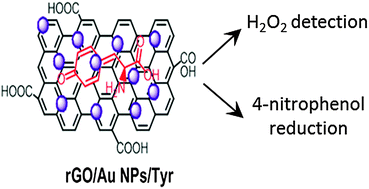One-step synthesis of Au nanoparticle–graphene composites using tyrosine: electrocatalytic and catalytic properties†
Abstract
An easy and environmentally friendly method is described for the in situ synthesis of a reduced graphene oxide/gold nanoparticle (rGO/Au NPs) nanocomposite through the simultaneous reduction of GO and HAuCl4 using tyrosine in water. The rGO/Au NPs/Tyr nanocomposite has been characterized using different techniques such as UV-vis spectrometry, Fourier transform infrared (FTIR) spectroscopy, X-ray photoelectron spectroscopy (XPS), scanning electron microscopy (SEM), transmission electron microscopy (TEM) and electrochemical measurements. The electrocatalytic and catalytic activities of the resulting hybrid nanomaterial have been investigated for the nonenzymatic electrochemical detection of hydrogen peroxide (H2O2) and nitrophenol reduction, respectively. The sensor displayed a detection limit of 20 μM over a wide linear range from 0.02 to 25 mM with a sensitivity of 46.46 μM mM−1 cm−2. In addition, the sensor also showed good selectivity for H2O2 detection, long-term stability and reproducibility. Furthermore, the rGO/Au NPs/Tyr nanocomposite exhibited good catalytic activity toward 4-nitrophenol reduction.


 Please wait while we load your content...
Please wait while we load your content...